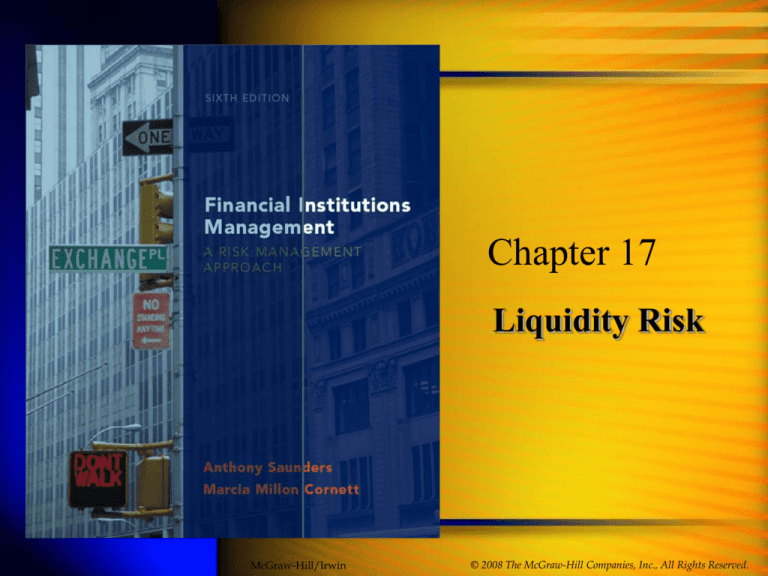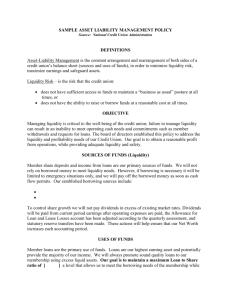
Chapter 17
Liquidity Risk
McGraw-Hill/Irwin
© 2008 The McGraw-Hill Companies, Inc., All Rights Reserved.
Overview
17-2
This chapter explores the problem of
liquidity risk faced to a greater or lesser
extent by all FIs. Methods of measuring
liquidity risk, and its consequences are
discussed. The chapter also discusses the
regulatory mechanisms put in place to
control liquidity risk.
FIs and Typical Liquidity Risk Exposure
High exposure
Moderate Exposure
DIs
Life Insurance Companies
Low exposure
Mutual funds, hedge funds, pension funds,
property—casualty insurance companies.
Typically low, does not mean zero:
September 2006, Amaranth Advisors, a hedge fund
forced to shut down
17-3
Causes of Liquidity Risk
Asset side
May be forced to liquidate assets too rapidly
Faster sale may require much lower price
May result from OBS loan commitments
Traditional approach: reserve asset
management.
Alternative: liability management.
17-4
Causes of Liquidity Risk for DIs
17-5
Liability side
Reliance on demand deposits
Core deposits
Depository Institutions need to be able to
predict the distribution of net deposit drains.
Seasonality effects in net withdrawal patterns
Early 2000s problem with low rates: finding suitable
investment opportunities for the large inflows
Managed by:
purchased liquidity management
stored liquidity management
Liability Management
17-6
Purchased liquidity
Federal funds market or repo market.
Managing the liability side preserves asset side
of balance sheet.
Borrowed funds likely at higher rates than
interest paid on deposits.
Deposits are insured
Regulatory concerns:
growth of wholesale funds and the potential for
serious problems in credit crunch
Liability Management
Alternative: Stored Liquidity Management
Liquidate assets.
In absence of reserve requirements, banks tend to
hold reserves. E.g. In U.K. reserves ~ 1% or more.
Downside: opportunity cost of reserves.
Decreases size of balance sheet
Requires holding excess non-interest-bearing
assets
Combine purchased and stored liquidity
management
17-7
Asset Side Liquidity Risk
17-8
Risk from loan commitments and other
credit lines:
met either by borrowing funds or
by running down reserves
Current
levels of loan commitments are
dangerously high according to
regulators.
Investment portfolio & asset side
liquidity risk
17-9
Interest rate risk and market risk of the
investment portfolio.
Technological improvements have increased
liquidity in financial markets.
Some argue that “herd” behavior may actually
reduce liquidity.
Measuring Liquidity Exposure
17-10
Net liquidity statement: shows sources and
uses of liquidity.
Sources: (i) Cash type assets, (ii) maximum
amount of borrowed funds available, (iii) excess
cash reserves
With liquidity improvements gained via securitization
and loan sales, many banks have added loan assets
to statement of sources
Uses include: borrowed or money market funds
already utilized, and any amounts already
borrowed from the Fed.
Other Measures:
17-11
Peer group comparisons: usual ratios
include borrowed funds/total assets, loan
commitments/assets etc.
Liquidity index:
Weighted sum of “fire sale price” P to fair market
price, P*, where the portfolio weights are the
percent of the portfolio value formed by the
individual assets.
I = S wi(Pi /Pi*)
Measuring Liquidity Risk
17-12
Financing gap and the financing requirement:
Financing gap = Average loans - Average
deposits or,
financing gap + liquid assets
= financing requirement.
The gap can be used in peer group
comparisons or examined for trends within
an individual FI.
Example of excessive financing requirement:
Continental Illinois, 1984.
BIS Approach:
17-13
Maturity ladder/Scenario Analysis
For each maturity, assess all cash inflows
versus outflows
Daily and cumulative net funding requirements
can be determined in this manner
Must also evaluate “what if” scenarios in this
framework
Web Resources
17-14
For further information on the BIS maturity
ladder approach, visit:
Bank for International
Settlements www.bis.org
Liquidity Planning
17-15
Important to know which types of depositors
are likely to withdraw first in a crisis.
Composition of the depositor base will
affect the severity of funding shortfalls.
Example: mutual funds/pension funds more
likely to withdraw than correspondent banks and
small businesses
Allow for seasonal effects.
Delineate managerial responsibilities clearly.
Bank Runs
17-16
Can arise due to concern about bank’s
solvency.
Failure of a related FI.
Sudden changes in investor preferences.
Demand deposits are first come first served.
Depositor’s place in line matters.
Bank panic: systemic or contagious bank
run.
Alleviating Bank Runs:
Regulatory measures to reduce likelihood of
bank runs:
17-17
FDIC
Discount window
Not without economic costs.
FDIC protection can encourage DIs to increase
liquidity risk.
Web Resources
17-18
For information about the Federal Reserve
Bank, visit:
Federal Reserve Bank
www.federalreserve.gov
Liquidity Risk for Other FIs
17-19
Life Cos. Hold reserves to offset policy
cancellations. The pattern is normally
predictable.
An example: First Capital in California, 1991.
CA regulators placed limits on ability to
surrender policies.
Problem is less severe for P&C insurers since
assets tend to be shorter term and more liquid.
However, spikes in claims can be problematic.
Hurricane Andrew precipitated 11 bankruptcies and
wholesale restructuring of Florida insurance. Claims
due to sequence of hurricanes Charlie, Frances,
Ivan, and Jeanne (fall 2004) as large as losses from
Andrew.
Investment Funds
Mutual funds, hedge funds
17-20
Net asset value (NAV) of the fund is market
value.
The incentive for runs is not like the situation
faced by banks.
Asset losses will be shared on a pro rata basis
so there is no advantage to being first in line.
Hedge funds implicated in some severe
liquidity crises
Example: Long Term Capital Management
Pertinent Websites
BIS www.bis.org
Federal Reserve www.federalreserve.gov
FDIC www.fdic.gov
17-21








